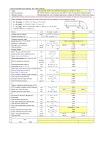What is a Pipe Schedule?
Pipe Wall thickness is expressed in “schedules“, referred to as pipe schedules. The pipe schedule is abbreviated as SCH. For a given size and schedule the thickness of the pipe is fixed and defined in the applicable ASME standard.
The pipe schedules are specified by different industrial standards including ANSI, ASME, and API.
The most commonly used pipe schedules are:
- Schedule 5
- Schedule 10
- Schedule 20
- Schedule 30
- Schedule 40
- Schedule 60
- Schedule 80
- Schedule 100
- Schedule 120
- Schedule 140 & more.
Schedule Number 40 is the most commonly used pipes in several industries like marine piping, industrial piping, processing industries, and oil & gas refineries. For pipe 8-inches and under, Schedule 40 and standard weight pipe wall thicknesses are the same.
Schedules 5, 60, 100, 120, & 140 are rarely used. This should be considered when piping is specified for a particular project. Other than the pipe schedule, pipe thickness can also be specified in mm or inches to the value corresponding to that specified in the ASME standard.
Definition of Pipe Schedule :-
The pipe schedule number indicates the calculated value of equation 1000 x (P/S). In which P is known as service pressure and S is allowable stress both are in psi (pounds per square inches). Let’s see the proper mathematical expression with examples.
Schedule Number = 1000 x (P/S)
Where, P = internal working pressure, (psi)
S = allowable stress (psi) of the material of construction at working conditions.
Example: Find-out the schedule number of pipe having working pressure 375 psi and allowable stress
10,000 psi?
Schedule Number = 1000 * (375/10,000) = 37.5 (approx. 40)
What Standards Govern Pipe Sizes?
In the oil and gas and related downstream industries the most common standards are
- ASME/ANSI B 36.10 Welded and Seamless Wrought Steel Pipe, and
- ASME/ANSI B36.19 Stainless Steel Pipe
When it comes to measurement of pipe, it is measure by the inside diameter, often called the nominal diameter. Nominal Pipe Size (NPS) is a North American set of standard sizes for pipe. The term nominal refers to pipe in non-specific terms and identifies the inside diameter with a non-dimensional number. For example, a 2-inch nominal steel pipe consists of a family of steel pipe with a 2.375″ diameter.
Pipe also has a wall thickness which is referred to by its schedule. The outside of the pipe is always larger than the inside. The difference between the inside diameter (ID) and the outside diameter (OD) is due to the thickness of the wall. Wall thickness also determines the strength of the pipe.
The 14 inch and larger sizes have the OD equal to the nominal pipe size. Tubing however is sized to the outside diameter for all applications.
Pipe Sizes 3/8'' , 1 1/4'' , 3 1/2'' , 4 1/2' and 5 inches are considered as non-standard and should not be used except to connect to equipment having these sizes. In this case the line is increased to a standard size as soon as it leaves the equipment.
Download Pipe Schedule Chart's with below Link










-page-001.jpg)



0 Comments